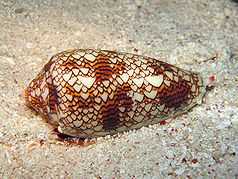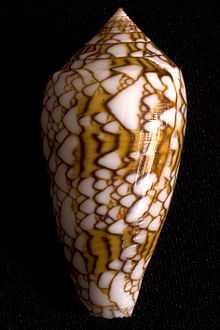Conus textile
| Conus textile | |
|---|---|
 | |
| A live individual of Conus textile, head end towards the right | |
| Scientific classification | |
| Kingdom: | Animalia |
| Phylum: | Mollusca |
| Class: | Gastropoda |
| (unranked): | clade Caenogastropoda clade Hypsogastropoda clade Neogastropoda |
| Superfamily: | Conoidea |
| Family: | Conidae |
| Genus: | Conus |
| Species: | C. textile |
| Binomial name | |
| Conus textile Linnaeus, 1758 | |
| Synonyms[1] | |
| |
Conus textile, common name the Textile Cone or the cloth of gold cone[2] is a venomous species of sea snail, a marine gastropod mollusk in the family Conidae, the cone snails, cone shells or cones.
Like all species within the genus Conus, these snails are predatory and venomous. They are capable of "stinging" humans, therefore live ones should be handled carefully or not at all. The conotoxin of this species is extremely dangerous to humans.
Distribution
C. textile lives in the waters of the Red Sea, Indo-Pacific, Australia, New Zealand, the Indian Ocean from eastern Africa to Hawaii, and French Polynesia.[3]
Subspecies:
- Conus textile archiepiscopus Hwass in Bruguière, 1792 (synonyms : Conus archiepiscopus Hwass in Bruguière, 1792 ; Conus cholmondeleyi Melvill, 1900 ; Conus communis Swainson, 1840 ; Conus episcopus var. elongata Dautzenberg, 1937; Conus eumitus Tomlin, 1926 ; Conus pyramidalis Lamarck, 1822; Conus pyramidalis Lamarck, 1810 ; Conus sirventi Fenaux, 1943 ; Conus suzannae van Rossum, 1990 ; Conus textile dahlakensis da Motta, 1982; Conus textile var. euetrios G. B. Sowerby III; Conus textile var. loman Dautzenberg, 1937; Conus textilinus Kiener, 1845)
- Conus textile neovicarius da Motta, 1982
Shell description

Typical length of adults is about 9 cm to 10 cm (3.5 in to 3.9 in).[1] The maximum shell length for this species is 15 cm (5.9 in).[4] The color pattern of its shell resembles a cellular automaton named rule 30.[5] The color of the shell is yellowish brown, with undulating longitudinal lines of chocolate, interrupted by triangular white spaces. These last are irregularly disposed, but crowded at the shoulder, base and middle so as to form bands. The spire is similarly marked. The aperture is white.[6]
Ecology
Life cycle
The female lays several hundred eggs at a time, which hatch after about 16 or 17 days. After hatching, the larvae float around in the current for approximately 16 days. Afterward, they settle at the bottom of the ocean. By this point their length is about 1.5 mm (0.06 in).[7]
Feeding habits
C. textile is a carnivorous species, and uses a radula (a biological microscopic needle) to inject a conotoxin to kill its prey. C. textile eats snails.[8] The proboscis, the tip of which holds the harpoon-like radular tooth, is capable of being extended to any part of its own shell. The living animal is a risk to any person handling it who has not taken proper care to protect exposed skin. Several human deaths have been attributed to this species.[9][10]
Human uses
In popular culture
- The animal was used as a murder weapon in the season 4 episode of Hawaii Five-O called "Cloth of Gold."[11]
References

- ↑ 1.0 1.1 "World Register of Marine Species". Conus textile Linnaeus, 1758. 2009. Retrieved 23 February 2010.
- ↑ Conus textile textile
- ↑ "Online Learning Center: Textile Cone Snail". Aquarium of the Pacific. Retrieved 2009-11-06.
- ↑ Poutiers, J. M. (1998). "Gastropods". In Carpenter, K. E. The living marine resources of the Western Central Pacific. FAO Species Identification Guide for Fishery Purposes 1. Rome: FAO. p. 628. ISBN 92-5-104051-6.
- ↑ Stephen Coombes (February 2009). "The Geometry and Pigmentation of Seashells". www.maths.nottingham.ac.uk. University of Nottingham. Retrieved 2013-04-10.
- ↑ George Washington Tryon, Manual of Conchology vol. VI, p. 90; 1879
- ↑ Textile Cone Snail
- ↑ Conus textile Linnaeus, 1758. Textile cone, 107 mm
- ↑ Cloth-of-Gold (Full Screen, Please)
- ↑ Textile Cone Shell(Conus textile)
- ↑ Five-O Oddities, Goofs, Trivia -- Season 4
- Drivas, J. & M. Jay (1988). Coquillages de La Réunion et de l'île Maurice
- Filmer R.M. (2001). A Catalogue of Nomenclature and Taxonomy in the Living Conidae 1758 - 1998. Backhuys Publishers, Leiden. 388pp.
- Branch, G.M. et al. (2002). Two Oceans. 5th impression. David Philip, Cate Town & Johannesburg
- Spencer, H.; Marshall. B. (2009). All Mollusca except Opisthobranchia. In: Gordon, D. (Ed.) (2009). New Zealand Inventory of Biodiversity. Volume One: Kingdom Animalia. 584 pp
- Tucker J.K. (2009). Recent cone species database. September 4, 2009 Edition
- Tucker J.K. & Tenorio M.J. (2009) Systematic classification of Recent and fossil conoidean gastropods. Hackenheim: Conchbooks. 296 pp
External links
| Wikimedia Commons has media related to Conus textile. |